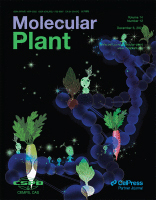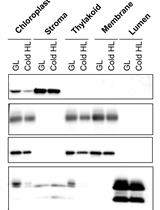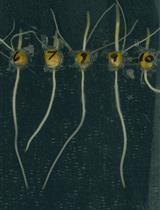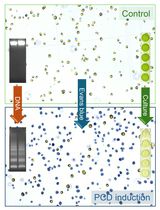- EN - English
- CN - 中文
Determination of Paraquat in Arabidopsis Tissues and Protoplasts by UHPLC-MS/MS
UHPLC-MS/MS法测定拟南芥组织和原生质体中百草枯的含量
(*contributed equally to this work) 发布: 2023年04月05日第13卷第7期 DOI: 10.21769/BioProtoc.4642 浏览次数: 1537
评审: Demosthenis ChronisAnonymous reviewer(s)
Abstract
Paraquat is a cost-effective herbicide, widely used in many countries, that can induce severe oxidative stress in photosynthetic tissues. Studying plant herbicide resistance or antioxidant stress mechanisms requires determining the cellular paraquat level when plants are treated by paraquat. The traditional isotopic labeling method has the potential risk to cause problems to both human health and the environment. For radioisotope manipulation, special operation spaces and strict environmental inspection are also required. In addition, the radiolabeled paraquat is increasingly hard to buy due to the extended production cycle. Here, we describe a nonradioactive method to determine the paraquat level in a small number of Arabidopsis tissues or protoplasts, using a high resolution ultra-high-performance liquid chromatography (UHPLC)-mass spectrometry (MS)/MS method. This method is highly selective and sensitive, and more environmentally compatible and technically feasible than the isotope detection method.
Keywords: Paraquat (百草枯)Background
Paraquat (PQ, 1,1-dimethyl-4,4-bipyridinium dichloride, or commonly called methyl viologen) is a nonselective herbicide that has been widely used in many countries for over half a century (Farrington et al., 1973; Fussell et al., 2011). It acts on chloroplasts and kills plants in several hours. PQ accepts electrons from photosystem I and transfers them to molecular oxygen, thus generating highly toxic reactive oxygen species (ROS) and causing severe oxidative stress in green tissues (Farrington et al., 1973; Fussell et al., 2011;Hawkes, 2014). In the past decades, a lot of PQ-resistant weeds have been found in the field. Studying plant resistance mechanisms to PQ not only helps to understand how weeds evolve herbicide resistance, but also promotes the understanding of plant antioxidant stress mechanisms. In Arabidopsis, a number of PQ-resistant mutants have been reported, including rmv1 (resistant of methyl viologen 1) (Fujita et al., 2012), par1 (paraquat-resistant 1) (Li et al., 2013), atpdr11 (pleiotropic drug resistance 11) (Xi et al., 2012), rcd1 (radical-induced cell death 1) (Fujibe et al., 2004), pst1 (photoautotrophic salt tolerance 1) (Tsugane et al., 1999), par2 (paraquat-resistant 2) (Chen et al., 2009), pqt3 (paraquat tolerance 3) (Luo et al., 2016), dtx6 (Lv et al., 2021; Xia et al., 2021), and atpqt11 (paraquat tolerance 11) (Huang et al., 2022), and the mutant genes responsible for this resistance have been identified. The resistance mechanisms revealed so far have been classified into three types: impaired uptake and transport of PQ, enhanced sequestration of PQ, and enhanced ROS scavenging ability (Nazish et al., 2022).
We identified a new PQ-resistant mutant rtp1 (resistant to paraquat 1), in which a MATE (multidrug and toxic compound extrusion) family protein DTX6 is disrupted (Lv et al., 2021). MATE family proteins are a type of transporters with distinct substrate specificity. To elucidate the resistance mechanism of DTX6, it is important to measure the PQ level in cells after treatment. The isotopic labeling method has been used to track exogenous molecules in plants; however, radiolabeled PQ is becoming increasingly difficult to obtain, and the manipulation of radioisotopes needs very complex approval and inspection procedures. Therefore, we established a nonradioactive method to determine PQ content in cells by combining ultra-high-performance liquid chromatography (UHPLC) and mass spectrometry (MS) systems. The UHPLC-MS/MS can determine PQ by using the multiple reaction monitoring mode of triple-quadrupole mass spectrometry. It has high selectivity and sensitivity and can achieve a resolution of 10-15 mol/L on column. Compared with traditional radiolabeling, the UHPLC-MS/MS method is more environmentally compatible and easier to implement.
Materials and Reagents
50 mL conical centrifuge tube (PROMETHE, catalog number: PCT010500, sterile)
15 mL conical centrifuge tube (PROMETHE, catalog number: PCT010150, sterile)
2 mL centrifuge tube (Shanghai Jing Xin, catalog number: JX-LG0100, nonsterile)
2.0 mL amber screw vial (Thermo Fisher, catalog number: C5000-2W)
150 μL liner pipe (Thermo Fisher, catalog number: C4012-530)
Two-week-old Arabidopsis seedlings grown on 1/2 MS plates (mutant seeds are available via email request to the corresponding author, and wildtype seeds are available from TAIR website https://www.arabidopsis.org)
Four-week-old Arabidopsis plants grown in soil
Murashige & Skoog basal medium with vitamins (PhytoTech, catalog number: M519)
KCl (Sinopharm Chemical Reagent Co., Ltd, CAS: 7447-40-7)
CaCl2 (Solarbio, CAS: 10043-52-4)
NaCl (Sinopharm Chemical Reagent Co., Ltd, CAS: 7647-14-5)
HCl (Sinopharm Chemical Reagent Co., Ltd, CAS: 7647-01-0)
MES (BBI, CAS: 145224-94-8)
NH4OAC (Sinopharm Chemical Reagent Co., Ltd, CAS: 631-61-8)
Paraquat (Aladdin, CAS: 1910-42-5)
Water (LC-MS-grade) (Merck, Milli-Q IQ7000)
Methanol (LC-MS-grade) (Merck, CAS: 67-56-1)
Acetonitrile (LC-MS-grade) (Sigma-Aldrich, CAS: 75-05-8)
Formic acid (LC-MS-grade) (Sigma-Aldrich, CAS: 64-18-6)
Liquid nitrogen
W5 buffer (see Recipes)
Paraquat treatment buffer (see Recipes)
Wash buffer (see Recipes)
Paraquat extraction solution (see Recipes)
Redissolving solution (see Recipes)
LC mobile phase (see Recipes)
Equipment
Automatic sample fast grinder (Shanghai Jing Xin, model: JXFSTPRP-CL)
Ultrasonic cleaners (Supmile, model: KQ-200VDE)
Nitrogen blowing concentrator (Beijing Jiayuan Industrial Technology Co., Ltd., model: MD200-2)
High-speed refrigerated centrifuge (KUBOTA, model: 6500)
Table high-speed centrifuge (Hettich, model: MIKRO 220R)
Light microscopy (Leica, model: Stereo microscope S8 APO)
-80 freezer
Water bath (HEDE Laboratory, model: DK-420BS)
Hemocytometer
UHPLC system (Shimadzu Nexera UHPLC LC30A system, including sample manager, solvent manager, and column oven)
Mass spectrometer system (SCIEX QTRAP 6500 plus mass spectrometer equipped with an electrospray ionization)
UHPLC column (ACQUITY UPLC BEH HILIC Column, 130Å, 1.7 µm particle size, 2.1 mm × 100 mm, Waters)
Procedure
文章信息
版权信息
© 2023 The Author(s); This is an open access article under the CC BY license (https://creativecommons.org/licenses/by/4.0/).
如何引用
Zhao, M., Wang, Q., Shi, M., Sun, Z., Tang, H. and Ge, X. (2023). Determination of Paraquat in Arabidopsis Tissues and Protoplasts by UHPLC-MS/MS. Bio-protocol 13(7): e4642. DOI: 10.21769/BioProtoc.4642.
分类
植物科学 > 植物生理学 > 非生物胁迫
环境生物学 > 植物
生物化学 > 其它化合物
您对这篇实验方法有问题吗?
在此处发布您的问题,我们将邀请本文作者来回答。同时,我们会将您的问题发布到Bio-protocol Exchange,以便寻求社区成员的帮助。
Share
Bluesky
X
Copy link













